Home
The Viewer as Poet: The Renaissance Response to Art
Loading Inventory...
Barnes and Noble
The Viewer as Poet: The Renaissance Response to Art
Current price: $77.95


Barnes and Noble
The Viewer as Poet: The Renaissance Response to Art
Current price: $77.95
Loading Inventory...
Size: OS
*Product Information may vary - to confirm product availability, pricing, and additional information please contact Barnes and Noble
In
The Viewer as Poet
, Norman Land provides the first comprehensive survey of ekphrasis in literature and art criticism from antiquity through the Renaissance. Land demonstrates, more fully than anyone has so far, that Renaissance art criticism assimilated the poetic tradition of ekphrasis while maintaining its function of analyzing works of art.
Broadly speaking, the book shows that purely literary descriptions of art in poetry and prose contain a response like that found in art-critical ekphrasis. This is true in both antiquity and the Renaissance. The response to art in the elder Philostratus's
Imagines
, for example, is like that found in the descriptions of Apuleius and Lucian. Later Dante, Boccaccio, and Poliziano, among others, respond to imaginary works of art in their poetry in much the same way that Lorenzo Ghiberti, Aretino, and Vasari respond to real works in their writings.
Land offers for the first time a synthetic description of the Renaissance response to, or experience of, art as embodied in literature, including art criticism. This book will form the basis for a deeper understanding of Renaissance art than we have now, for it provides not only a tool for viewing works of art as they were originally seen and experienced—that is, from a historical perspective—but also an outline of the tradition out of which modern writings about art grew.
The Viewer as Poet
, Norman Land provides the first comprehensive survey of ekphrasis in literature and art criticism from antiquity through the Renaissance. Land demonstrates, more fully than anyone has so far, that Renaissance art criticism assimilated the poetic tradition of ekphrasis while maintaining its function of analyzing works of art.
Broadly speaking, the book shows that purely literary descriptions of art in poetry and prose contain a response like that found in art-critical ekphrasis. This is true in both antiquity and the Renaissance. The response to art in the elder Philostratus's
Imagines
, for example, is like that found in the descriptions of Apuleius and Lucian. Later Dante, Boccaccio, and Poliziano, among others, respond to imaginary works of art in their poetry in much the same way that Lorenzo Ghiberti, Aretino, and Vasari respond to real works in their writings.
Land offers for the first time a synthetic description of the Renaissance response to, or experience of, art as embodied in literature, including art criticism. This book will form the basis for a deeper understanding of Renaissance art than we have now, for it provides not only a tool for viewing works of art as they were originally seen and experienced—that is, from a historical perspective—but also an outline of the tradition out of which modern writings about art grew.


















